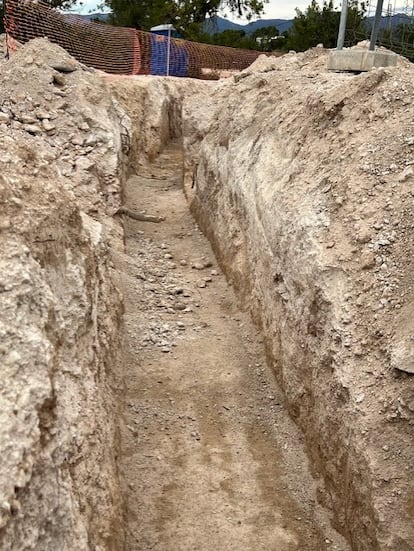The development works of a new complex of chalets and townhouses have come across trenches, machine gun nests and other fortifications from the Spanish Civil War. They belonged to the Puig-Carasols or Immediate line, built in 1938 to defend Valencia from the attacks of Franco’s troops. They were never used, but they have a lot of history. Once the war was over, the vestiges were covered by crop fields and the passage of time. A couple of months ago, with the reactivation of an old PAI (Integrated Action Plan) they came to light again. The initial project plans to build 222 homes there, which will have a price of more than half a million euros each, according to the promotion of a real estate agency.
The works have been paralyzed only in the area of the finds while waiting for the Heritage services of the Ministry of Culture to issue a report to “indicate the way to proceed with the finds” that were not previously cataloged, they say. to this newspaper sources from the Bétera City Council, to which the exclusive urbanization of Mas Camarena belongs, about 12 kilometers from Valencia, attached to the land where the military heritage has appeared. The department indicates that it continues preparing the report, but remembers that other elements already inventoried of the defensive line, which ran for almost 29 kilometers through various municipalities from El Puig to Vilamarxant, have the protection of Asset of Local Relevance, and therefore Therefore, they are under municipal jurisdiction. From the Bertolín Group, the construction company, they point out that they are waiting for the authorities’ determination.

The neighbors who make up the Mas Camarena association sound the alarm. They maintain that “the works of PAI R13, rescued from twenty years ago,” threaten “the integrity of these important vestiges” and demand their protection so that “they are not lost into oblivion.” “The works continue, as we have verified, although they tell us not in the area of trenches and other fortifications. It is urgent to act now. We believe that it is worth preserving this heritage of our history. And there are various ways to do it, such as integrating it into a garden, for example. In short, we want to preserve a part of our past,” says Paco Fuentes, from the Mas Camarena neighborhood association, where about 3,500 people live. The entity proposes informative activities and has appeared before institutions to inquire about the future of a military heritage that is largely unknown, but that attracts more and more attention and not only from specialists.
The Basque Government, for example, declared the so-called Bilbao Iron Belt of Cultural Interest (BIC), a fortification system made up of tunnels, bunkers and trenches built by the Republicans during the Civil War that the Franco army overcame to take the city, highlights José Durbán. This historian has been studying the unfinished Immediate Line for years and has inventoried a hundred “elements, different types of machine gun forts, anti-tank elements, anti-aircraft artillery spaces, trenches, shelters, bunkers.” “It was not used as a battle line. It was the rearguard defense, closest to Valencia. When it is built, the end of the Battle of Levante occurs [también llamada Ofensiva o Campaña]. Franco’s troops could not overcome the defense of the XYZ line and in July 1938 the Battle of the Ebro began, so the war scenario changed,” he explains.
More than continuous lines, the Republican army designed a defensive “mesh”, a set of defensive centers of resistance, after the experience of Bilbao: first the XYZ (or Matallana Line, from Nules to Santa Cruz de MNoya), then the intermediate Palancia and finally the rearguard. “What came out in Mas Camarena was not visible and was not inventoried, but it is part of a group of Immediata. The rest of the cataloged vestiges are declared Assets of Local Relevance, based on the modification of the Heritage Law that was carried out in 2017,” points out the historian, who has written about the figure of Lieutenant Colonel of Engineers Sebastián Carrer Vilaseca, who directed the construction of the Immediate. “In 85 years, some constructions on the line have miraculously survived. We must respect and conserve this heritage, otherwise it will disappear,” he says.
What affects the most is what happens closest. So you don’t miss anything, subscribe.
Subscribe
The historian considers that there are alternative formulas to respect and combine the right to land use with respect for heritage. The reactivation of PAIs in the area, highly valued due to its proximity to Valencia, represents a threat to these groups. “Military artifacts always have a political and social component that can make them uncomfortable, but it is part of our history. The Generalitat has the obligation to carry out an inventory of the Civil War, although 60% of what is cataloged in that defensive line does not appear on its website,” he points out.
The Bétera City Council, chaired by Elia Verdevío, from the PP, with the support of the Mas Camarena-Torre formation in Conill, highlights the actions it has carried out to locate, identify, highlight and signpost “the vestiges of the Puig-Torre line. Carasols or Immediate as it passes through Bétera.” Remember that the City Council has chaired the Association of Municipalities Linked to the Immediate Defensive Line since December 2022 and that it participates in a European project for the protection and promotion of an air-raid shelter for the population.

Subscribe to continue reading
Read without limits
_
#luxury #development #threatens #Inmediata #defensive #line #Valencia #Civil #War

